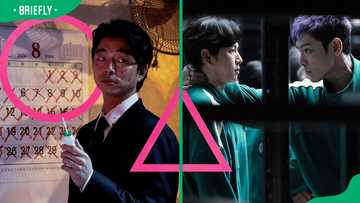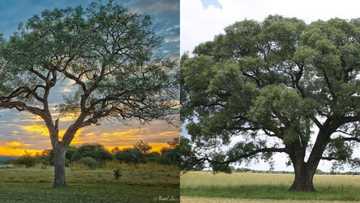What are the national symbols of South Africa and what do they mean?
South Africans celebrate their diversity through their country's national symbols. As a result, the national symbols of South Africa promote national unity and togetherness among the citizens. Discover the South African national symbols and their meanings below.
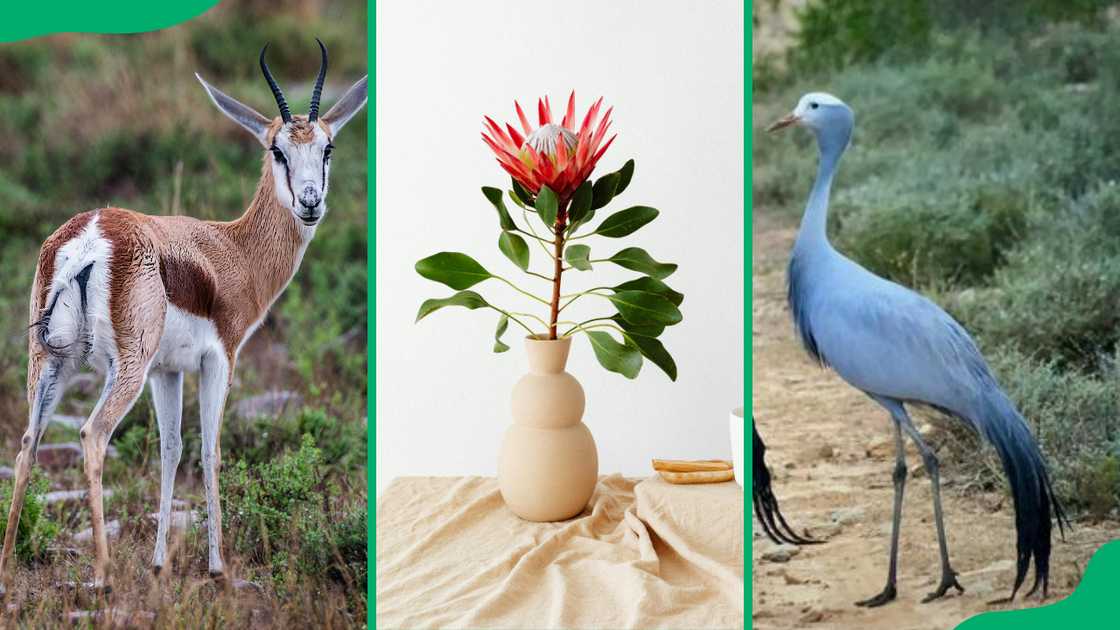
Source: UGC
TABLE OF CONTENTS
- The national symbols of South Africa and their meanings
- What are the national symbols of South Africa?
- What is the symbol of the South African culture?
- What is South Africa's national tree?
- What is the South African peace symbol?
- What animal represents Zulu?
The historical meanings behind South Africa's national symbols make them patriotic symbols. In other words, these national symbols represent South Africa's togetherness and historical journey as a state despite its different ethnic groups and diverse cultures.
The national symbols of South Africa and their meanings
If you have been wondering what these symbols are, this article shares pictures of the national symbols of South Africa and detailed research about their meanings:
1. The national Coat of Arms
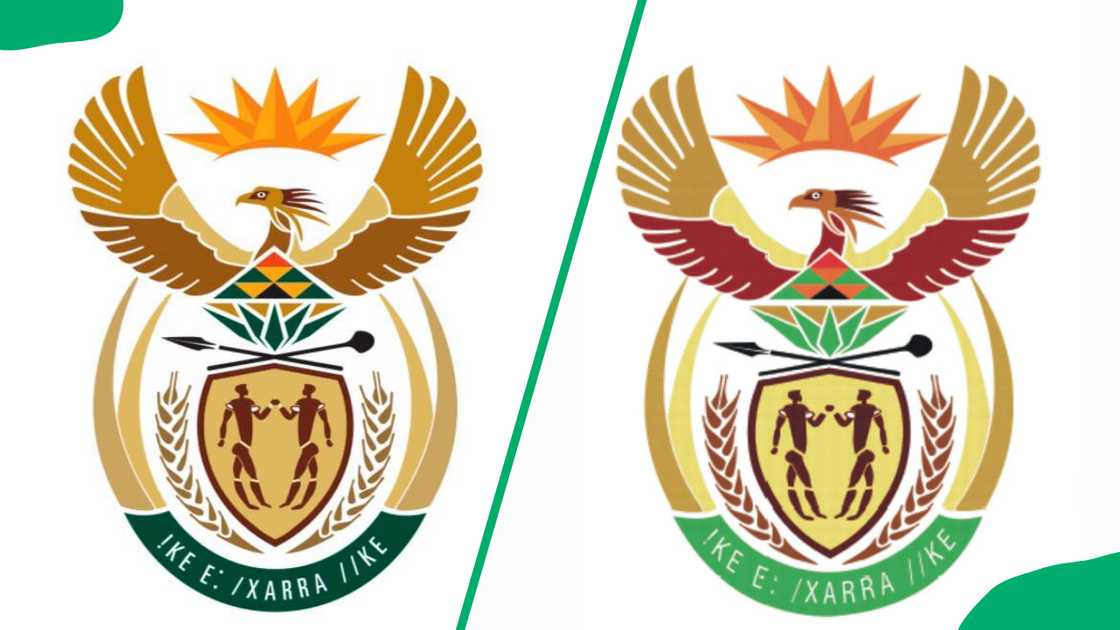
Source: UGC
The national Coat of Arms is the highest visual symbol of the Republic of South Africa (RSA). Its design is a series of elements organized in distinct symmetric egg-like or oval shapes placed on top of one another.
The present Coat of Arms was designed by Iaan Bekker and introduced on Freedom Day, 27 April 2000. It replaced the earlier national arms, which had been in use since 1910.
Here are the meanings of the elements found in the South African Coat of Arms:
- Elephant tusks – represent wisdom, strength, and eternity.
- The ears of wheat in an oval shape formed by the elephant tusks – symbolize fertility, development, and nourishment.
- The gold shield in a drum-like shape – a display of spiritual defense.
- The human figures – symbolize unity.
- The spear and knobkierie – symbolize defense, power, authority, and peace.
- The Protea – an emblem of the beauty of the South African land
- The secretary bird – symbolizes growth, protection, and power.
- The rising sun – an emblem of brightness, splendor, the promise of rebirth, and willpower.
2. The national flag
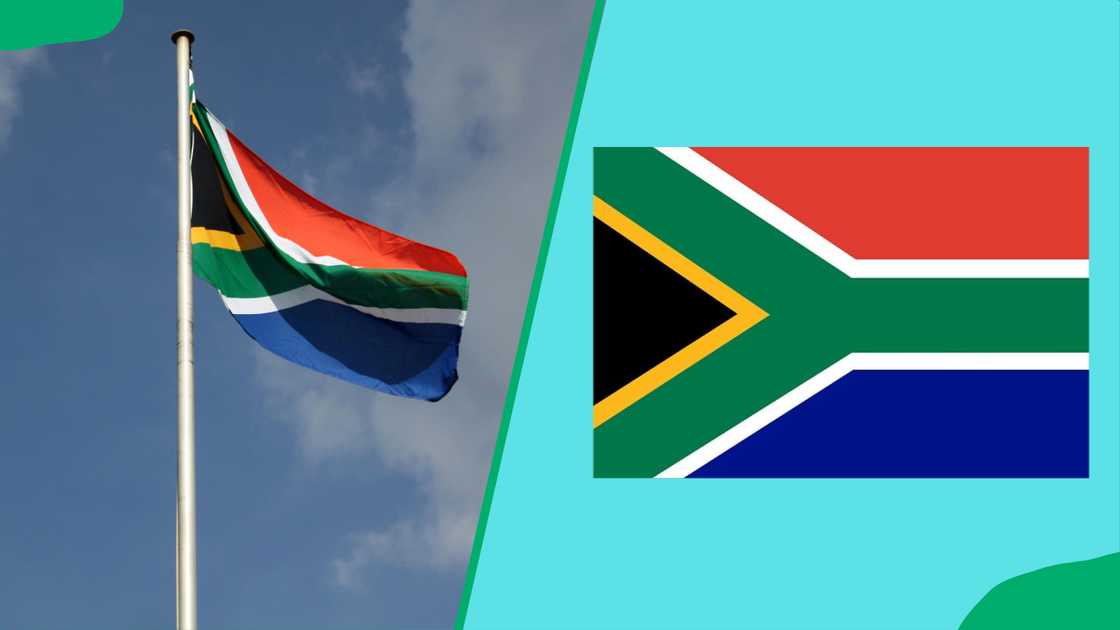
Source: UGC
The South African national flag was designed in March 1994 and adopted on 27 April 1994, during the 1994 general election, to replace the previous flag used from 1928 to 1994.
Blue represents many things, including the spirit of the South African people and the Indian and Atlantic Oceans. White represents the white people, while black represents the Black people who live in South Africa.

Read also
DA says Guptas' failed extradition is proof that Zuma is still present in government, Mzansi in debate
Meanwhile, green represents the love South Africans have for the land, and yellow represents gold, a prominent mineral in the country.
3. The national anthem
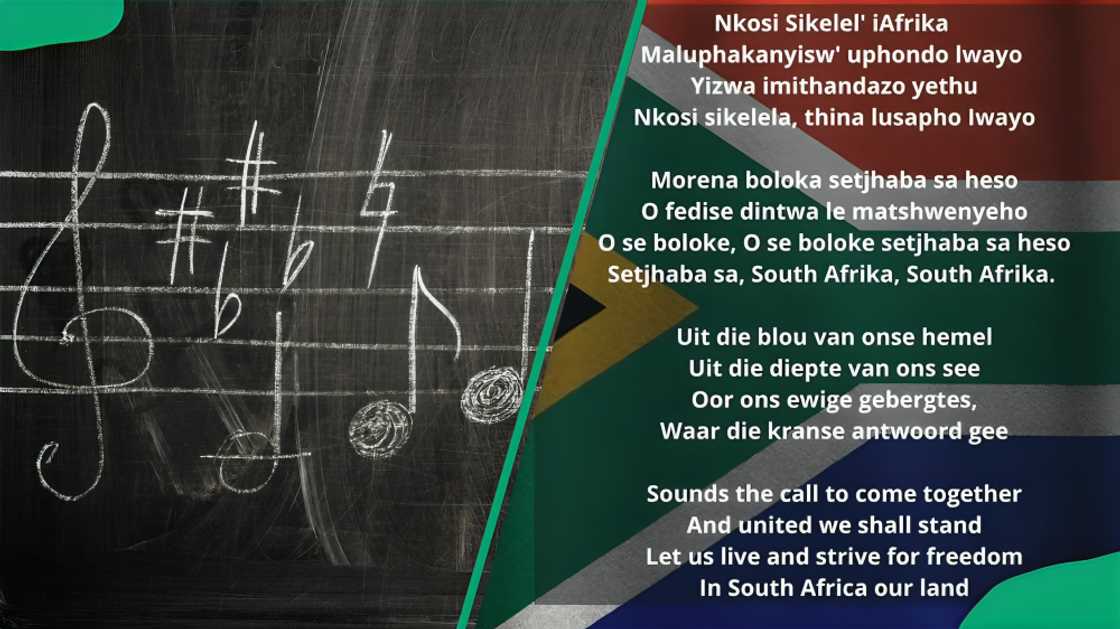
Source: UGC
The national anthem of South Africa was adopted in 1997. It is a hybrid song combining extracts of "Die Stem van Suid-Afrika," an Afrikaans song that was used as the national anthem during the apartheid era, and "Nkosi Sikelel' iAfrika," a 19th-century Xhosa hymn.
The lyrics of the South African national anthem employ the country's five most widely spoken official languages – Xhosa, Zulu, Sesotho, Afrikaans, and English.
4. The King Protea flower
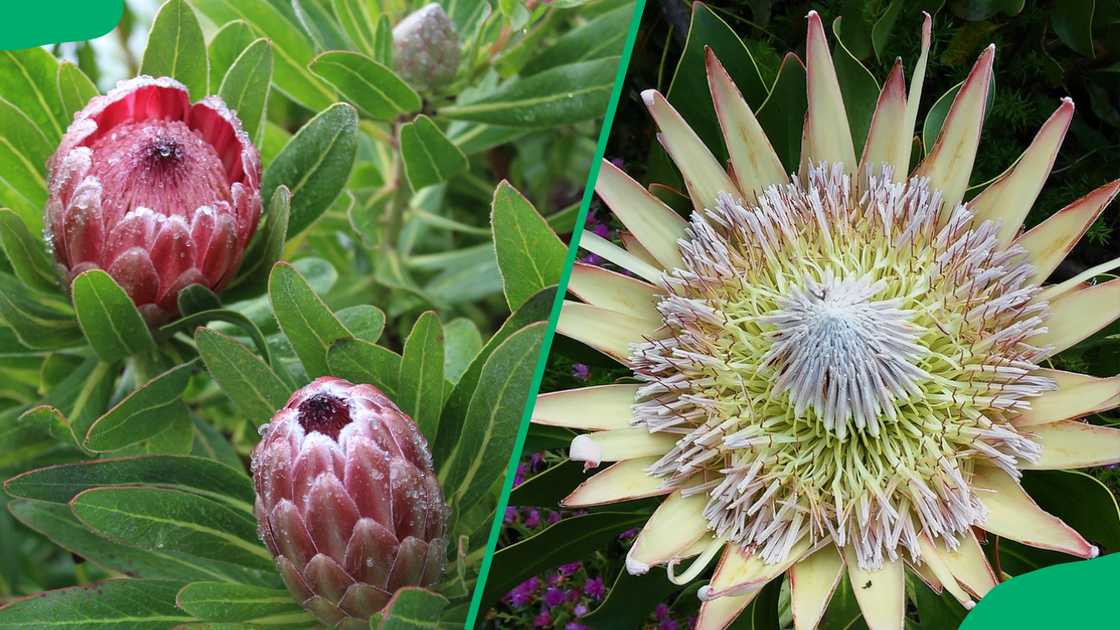
Source: UGC
King Protea was officially declared South Africa's national flower in 1976, presiding over the previous "Suikerbossie" flower (sugarbush).
The plant belongs to the botanical species Protea, and its alluring beauty mimics a king's crown. King Protea possesses the biggest flower head ever recorded by botanists. Its gigantic flower head has earned it English names like the "Giant Protea" and the "Honeypot."
Why is the Protea the national flower of South Africa?

Read also
Kwesta celebrates 16 years in the industry, announces upcoming concert at Carnival City Big Top Arena
King Protea was declared a South African flower because of its beauty and prolific dominance in the country. About 92% of the species occur only in the Cape Floristic Region. The plant is very common in the south and southwestern regions of SA’s Table Mountain and Fynbos terrain.
What does Protea flower mean?
The plant is mythologically associated with beauty, resilience, change, and transformation. As a result, it was declared a South African national flower to symbolize the unity of the people in spite of the country's continuous cultural transformations.
South Africa's horticultural farms grow over 80 varieties of King Protea because of its intriguing characteristics. For instance, it comes in diverse colors, from red to pink to yellow, and can regenerate quickly after being affected by wildfires.
The Protea's different colors represent the various races in SA, and its resilience to wildfires depicts the character of South Africans.
5. The native Yellowwood tree
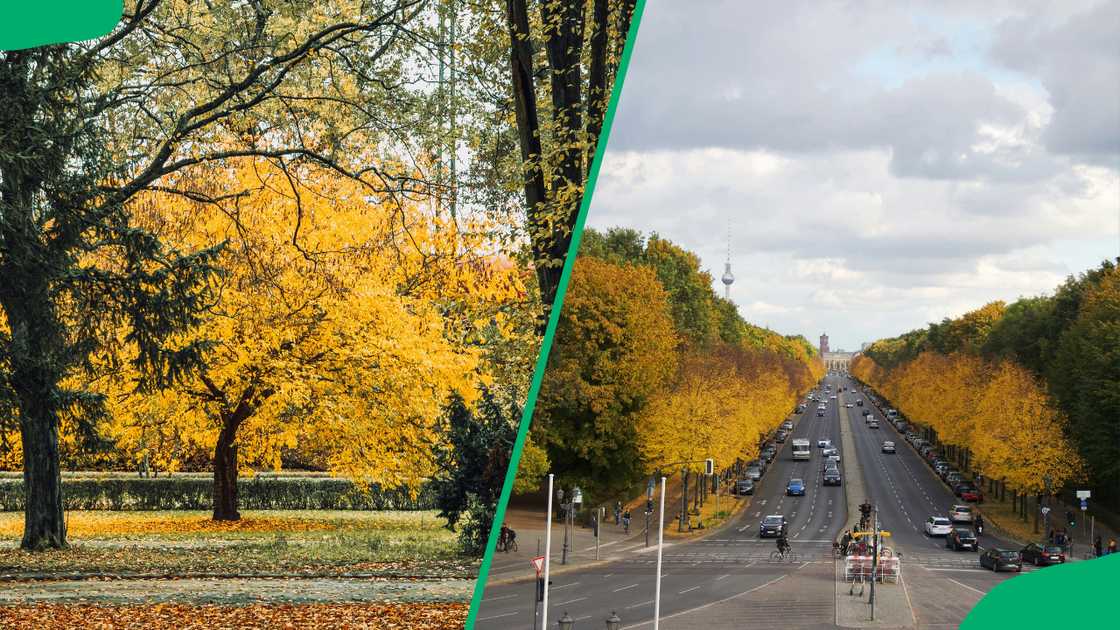
Source: UGC
The native Yellowwood tree is one of the South African national symbols because it has diverse uses in numerous ethnic groups of the country.
The tree's high-quality wood was historically used to make household products. The Zulu people call it “Umkhoba” while the Xhosas call it “Mogobagoba.”

Read also
2 SA former convicts advocate for education and prison reform as inaugural Global Freedom Fellows
What is the yellowwood tree?
The Yellowwood (Podocarpus Latifolius) is a large tree with evergreen leaves throughout the year. Botanically, it belongs to the species Podocarpaceae under the diverse conifer family.
The tree averagely reaches 35-50 m high in about 30 to 40 years and is known for its prolific wood products. Meanwhile, its smooth trunk that can grow up to 1.5 m in radius (3 m diameter)
The native Yellowwood is considered a South African national tree because of its historical countrywide dominance. It thrives in the harsh terrains of Afro-temperate forested areas.
You will find it growing stunted and rather smaller in size in the Table Mountain regions and the Western Cape regions, namely the KwaZulu and Limpopo terrains.
6. The Springbok antelope
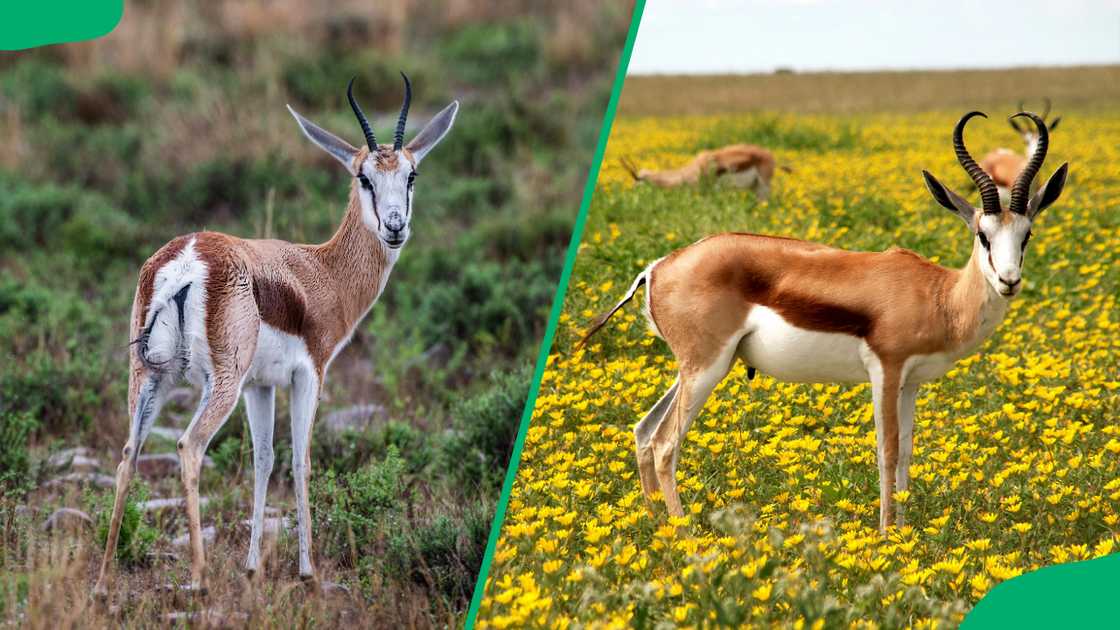
Source: UGC
Springbok is considered the national animal of South Africa. Its name was derived from the Afrikaans ethnic group. To them, "spring" means to jump, and "bok" means "goat."
The antelope is the emblem of the South African national rugby team (also known as the "Springboks"). The team's colors and uniform are also inspired by this wild animal.
The native Springbok antelope belongs to the Antidorcas Marsupialis species. It is only found in the southern and southwest regions of Africa.
You can identify this antelope through its distinctive features. It has a slim body with a long neck and legs. When mature, a Springbok antelope can achieve a shoulder height of 69-87 cm (27-34 inches) and a weight of 27-48 kg (59-106 pounds).
In addition, male and female Springboks have black horns that curve backward, reaching an average length of 35-49 cm (14-19 inches).
These animals are found in the relatively dry areas of South Africa, such as the Karoo region. You can spot them grazing at sunrise and sunset.
7. The Galjoen fish

Source: UGC
The Galjoen fish is called Black Bream fish in English or the blackfish in layperson's terms. Scientifically, it is known as Dichistius Capensis.
Galjoen is a good source of protein and promotes commercial and game fishing activities in South Africa. The fish is a marine equivalent to the Springbok antelope.
Margaret Smith, the wife of ichthyologist J. L. B. Smith, was among the pioneers who advocated for Galjoen to be adopted as South Africa's national fish to represent the country's marine life.
What is the South African national fish?
The Galjoen is considered a South African national emblem. The fish thrive in shallow waters (10 m depth), especially in South Africa's coral reefs. As a result, they dominate South Africa's coastal regions, specifically the stretch from Angola to SA.
The Galjoen fish feed on seaweeds that grow on the corals. A mature one can reach an impressive body length of 80 cm and an average weight of 6.5 kg.
8. The Blue Crane bird
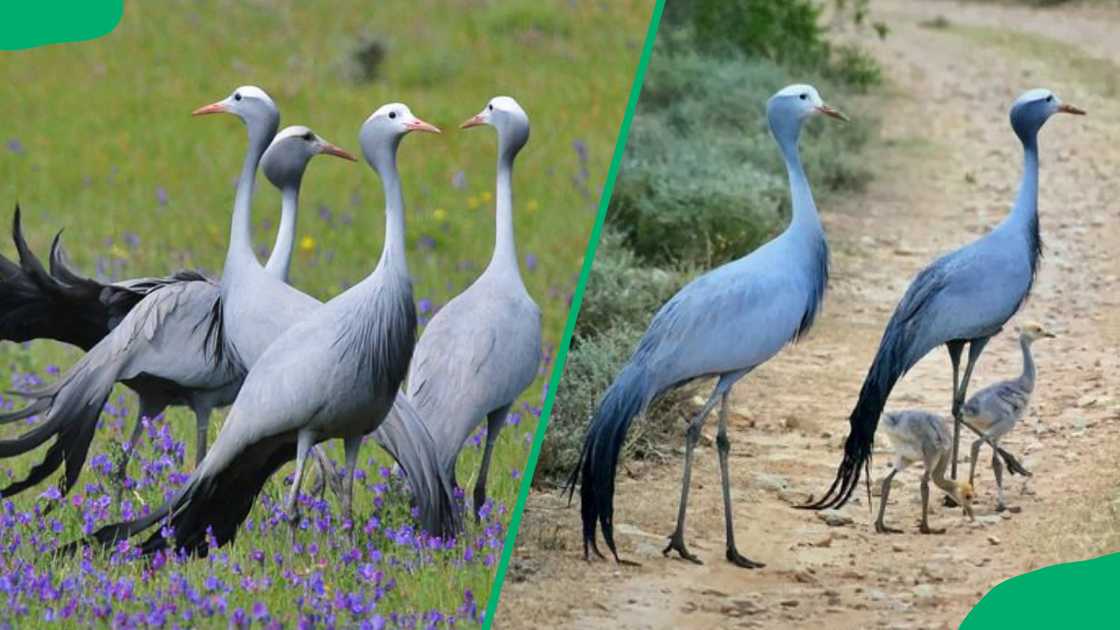
Source: UGC
The Blue Crane is the national bird of South Africa. Scientifically, it is referred to as Grus Paradise. As its name suggests, the bird has blue and gray colors, with the neck and head bearing darker shades up to the nape.
It is easy to distinguish a Blue Crane from other Crane birds because it has a larger head and thinner neck than the other species.
Mature Blue Cranes reach an average height of 100-120cm. The birds patch their nests and feed on grass and insects. They dominate grassy pastured terrains like grassy hills and valleys with wetlands and minimal tree growth.
What does the Blue Crane symbolize?
Blue Cranes symbolize bravery and beauty in some South African tribes. For instance, the Xhosas call the bird "Indwe," and the community's chiefs crown brave warriors with Blue Crane feathers. The warriors display the feathers in their hair.
According to the International Union for Conservation of Nature, the Blue Crane is considered to be among the ten endangered/vulnerable Crane species. A significant decline in the Blue Crane population was recorded in early 1980.
The leading reason behind the decline is the increased modernization and conversion of grassland areas to commercial and urban towns. As a result, the government is actively involved in their conservation.
How many symbols are there in South Africa?
South Africa has eight national symbols: the Coat of Arms, the national flag, the national anthem, the Springbok antelope, the Galjoen fish, the Yellowwood tree, the Blue Crane bird, and the King Protea plant.

Read also
Waste of taxpayers’ money: EFF slams R22m monumental flag project, tells Nathi Mthethwa to review use of funds
What are the national symbols of South Africa?
The eight South African national symbols are:
- The national Coat of Arms
- The national flag
- The national anthem
- The national bird - Blue Crane bird
- The national fish - Galjoen fish
- The national flower - King Protea flower
- The national animal - Springbok antelope
- The national tree - The native Yellowwood tree
What is southern Africa's national animal?
The native Springbok antelope is South Africa's national animal symbol.
What is the symbol of the South African culture?
The native Yellowwood tree, the Blue Crane bird, the Galjoen fish, the Springbok antelope, and the King Protea flower are symbols of the South African culture.
What is South Africa's national tree?
The native Yellowwood tree is considered the national tree of South Africa.
What is the South African peace symbol?
The spear and knobkierie on the national Coat of Arms represent peace.
What is South Africa's national color?
The South African national flag has six colors: red, white, blue, black, yellow, and green, each with a particular meaning.
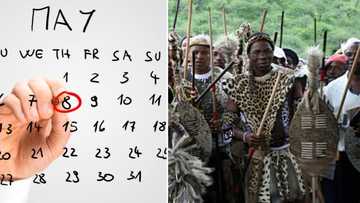
Read also
Civil society groups call for Ancestors' Day to be made a formal public holiday to honour African spirituality
What animal represents Zulu?
The leopard is revered as a totem animal among the Zulu, who call it "Ingwe." For them, the leopard symbolizes all that is noble, courageous, and honorable. Zulu royalty wears leopard skins in ceremonial events.
The national symbols of South Africa represent the people's history, culture, and patriotism. South Africans are generally affectionate, protective, and expressive. So, their national symbols are one way of expressing their identity to the world.
Briefly.co.za shared images of the best tribal tattoos for men and women. These tattoos are a form of identification, with symbols representing different tribes or social groups.
Some tribes use tattoos as a rite of passage or for ceremonial or spiritual purposes. In some cases, tribal tattoos were used to mark enslaved people or criminals.
Source: Briefly News

